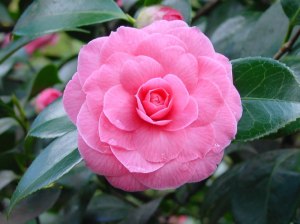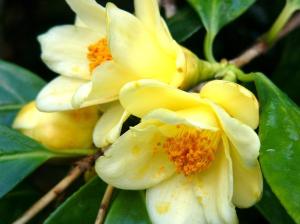If you live down south, the camellias flower through the winter. The American Camellia Society has nine acres of plantings at Massee Lane Gardens in Fort Valley, Georgia (south of Macon). The society was founded in 1945 and is “dedicated to fostering appreciation for and knowledge of plants of the genus Camellia.” The genus is a member of the family Theaceae, which rather gives away the inclusion of the plant from which we make tea, Camellia sinensis. But more people likely know the genus as a source of thousands of cultivars grown as ornamental plants.

In the United States the camellia is most popular in the South because most varieties are only hardy north to USDA Zone 7, which extends north into Virginia, although a few can tolerate Zone 6 (southern Pennsylvania). They can be planted as far south as Zone 10. Most cultivated varieties come from the wild species C. japonica and C. sasanqua, but others, like C. reticulata and C. higo, have also been used as starting points.
There are perhaps 250 wild species in a range extending from the Himalayas east to Japan and Indonesia. But camellias are so strongly associated with the American South that it is the state flower of Alabama. They were, however, brought to this country in 1797 and grown in greenhouses in New England.
As an ornamental shrub it is apparently relatively easy to grow. Most varieties are between 6 and 15 tall with either a rounded or pyramidal shape (or resembling a small tree). The evergreen leaves are usually a glossy, making the plant attractive even without blossoms on it. The flowers look like roses, and like roses the wild types have a single ring of petals, but the cultivated types are often doubled. Many species and varieties have prominent yellow stamens.

The color of most varieties—again like roses—ranges from white through a spectrum of pinks into red. Yellow-flowered camellias grow in south China and Vietnam and this color has been added to some cultivars. Some varieties have “variegated” petals, meaning they are streaked with more than one color.
The plants grow about a foot every year, which is regarded as slow-growing. For this reason, many of them are potted.
The cultivars derived from C. japonica bloom in the winter and the early spring, while those derived from C. sasanqua flower in the fall. The sasanqua varieties—which have darker leaves and smaller blooms—are hardier and tolerate drought and full sun more than the japonica varieties. Gardeners like to plant shrubs derived from both species in order to get a long period of bloom in their gardens. All camellias like well-drained, acidic (pH 6.0 to 6.5) soils.
<span styThey are shallow rooted, so although they prefer dappled light and can be planted under trees, they shouldn’t be placed under shallow-rooted trees like maples and birches

They don’t need a lot of pruning. C. japonica varieties should be pruned after they bloom in the spring, and C. sasanqua need to be pruned very early in the spring before the flower buds form. Removing some of the buds will encourage the remaining ones to produce larger, showier flowers.
C. japonica cultivars are most often used as specimen plants, while C. sasanqua varieties can be turned into hedges or topiaries and espaliated. The sasanqua types can tolerate pruning from a young age, but other varieties should be allowed to reach the height and shape that is desired or maturity (which ever comes first) before being pruned.
Very few diseases affect camellias, but they are host plants to many plant pathogens, so they are often grown separated from other species in nurseries.
When the flowers finish blooming, the calyx (the ring of sepals) falls with the corolla (petals), which is unusual. The Chinese have decided that the corolla symbolizes the spirit of a woman and the calyx that of a man (protecting the petals by surrounding them at the base). The fact that they fall together is considered a symbol of undying love.

You must be logged in to post a comment.